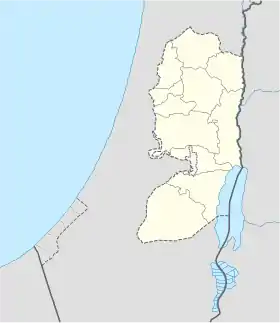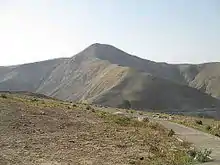 Wall at Alexandrium | |
 Shown within State of Palestine  Alexandrium (the West Bank) | |
| Alternative name | Alexandreion, Sartaba |
|---|---|
| Location | Jericho Governorate, West Bank |
| Region | Judea |
| Coordinates | 32°5′45″N 35°27′41″E / 32.09583°N 35.46139°E |
| Type | Fortification |
| History | |
| Builder | Probably Alexander Jannaeus |
| Founded | 1st century BCE |
| Abandoned | About 70 CE |
| Periods | Hellenistic to Roman Empire |

Alexandreion[1] (Greek), or Alexandrium (Latin), called Sartaba in the Mishna and Talmud and Qarn Sartaba in Arabic, was an ancient hilltop fortress constructed by the Hasmoneans[2] between Scythopolis and Jerusalem on a pointy barren hill towering over the Jordan Valley from the west.[3] It was likely named after Hasmonean king Alexander Jannæus (104-77 BCE).
Name
The fortress called "Alexandreion" in Greek, simplified to "Alexandrion" (and Latinised as "Alexandrium"), is mentioned by Josephus in his Antiquities of the Jews. It was mentioned in the Mishna and Talmud as "Sartaba" and is now called "Qarn Sartabe" (lit. "Horn of Sartabe") in Arabic.[4]
History

Alexandrium was constructed by the Hasmoneans near the border with Samaria to accommodate a military garrison, as well as to guard political prisoners.[5] It is later mentioned during Pompey the Great's conquest of Judea as a stronghold of Aristobulus II: "...as he passed by Pella and Scythopolis, he came to Corem, which is the first entrance into Judea when one passes over the midland countries, where he came to a most beautiful fortress that was built on the top of a mountain called Alexandrium, whither Aristobulus had fled/"[6]
The Alexandreion was restored by Herod the Great, a task he assigned to his brother Pheroras. Herod gave it the character of a palatial desert fortress, similar to those he built or rebuilt at Masada, Herodion and Machaerus. Herod used the fortress as a prison for his political opponents, holding his 2nd wife, Mariamne and her mother, Alexandra there in 30 BCE. It was also the burial site of Alexander, son of Herod, and Aristobulus, two of his sons whom Herod had executed at Sebaste in 7 BCE.[3]
Alexandrium was finally razed by Vespasian or Titus during the Great Revolt.[7]
See also
- Hasmonean desert fortresses
- Dok (Dagon) on the Mount of Temptation
- Hyrcania (fortress)
- Cypros (German article)
- Machaerus
References
Notes
- ↑ Peter Richardson, Amy Marie Fisher (2018). Herod: King of the Jews and Friend of the Romans (2 ed.). Routledge. p. 392. ISBN 978-1-1388-0392-3. Retrieved 21 June 2018.
- ↑ Josephus, Antiquities of the Jews 13:417
- 1 2 Rocca 2008, pp. 30-32
- ↑ Abraham Schalit, König Herodes. Der Mann und sein Werk. Walter de Gruyter Inc., Studia Judaica, 2001, p. 12, footnote 40. German: "Josephus, AJ, XIV, 3, 4 (Par. 49). Alexandreion ist das Sartaba der Mischnah und des Talmud, heute Qarn Sartabe, etwa drei Meilen südwestlich von der Mündung des Jabboq in den Jordan." English translation: "Josephus, Antiquities of the Jews, XIV, 3, 4 (par. 49). Alexandreion is the Sartaba of the Mishnah and Talmud, today's Qarn Sartabe, about three miles southwest of the confluence of the Jabboq with the Jordan."
- ↑ Rocca 2008, p. 12
- ↑ Josephus, Antiquities of the Jews 14:48
- ↑ Krauss, Samuel. "ALEXANDRIUM". JewishEncyclopedia.com. Retrieved May 7, 2011.
Bibliography
- Josephus, Flavius. William Whiston, A.M., translator (1895). The Works of Flavius Josephus. Auburn and Buffalo, New York: John E. Beardsley. Retrieved 15 July 2010.
- Rocca, Samuel (2008). The Forts of Judaea 168 BC – AD 73. Oxford, United Kingdom: Osprey Publishing. ISBN 978-1-84603-171-7.